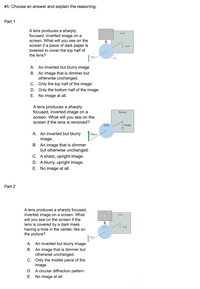
College Physics
11th Edition
ISBN: 9781305952300
Author: Raymond A. Serway, Chris Vuille
Publisher: Cengage Learning
expand_more
expand_more
format_list_bulleted
Concept explainers
Question

Transcribed Image Text:#5: Choose an answer and explain the reasoning.
Part 1
A lens produces a sharply
focused, inverted image on
screen. What will you see on the
screen if a piece of dark paper is
lowered to cover the top half of
Screen
Image
the lens?
Object
Lens
А.
An inverted but blurry image.
An image that is dimmer but
otherwise unchanged.
В.
C. Only the top half of the image.
D. Only the bottom half of the image.
E. No image at all.
A lens produces a sharply
focused, inverted image on a
Screen
screen. What will you see on the
screen if the lens is removed?
Lens
| Image
A. An inverted but blurry
image.
B. An image that is dimmer
but otherwise unchanged.
Object
C. A sharp, upright image.
D. A blurry, upright image.
E. No image at all.
Part 2
A lens produces a sharply focused,
inverted image on a screen. What
will you see on the screen if the
lens is covered by a dark mask
having a hole in the center, like on
the picture?
Screen
Lens
Image
Object
A. An inverted but blurry image.
B. An image that is dimmer but
otherwise unchanged.
C. Only the middle piece of the
image.
D. A circular diffraction pattern.
Е.
No image at all.
Expert Solution
This question has been solved!
Explore an expertly crafted, step-by-step solution for a thorough understanding of key concepts.
This is a popular solution
Trending nowThis is a popular solution!
Step by stepSolved in 2 steps with 2 images

Knowledge Booster
Learn more about
Need a deep-dive on the concept behind this application? Look no further. Learn more about this topic, physics and related others by exploring similar questions and additional content below.Similar questions
- provide justificationarrow_forwardw9-8 A diverging lens has a focal length of −8.00 cm. What is the nature of the image formed when the object is placed at a distance of 24.2 cm from the lens? a. virtual, upright, and diminished b. real, inverted, and diminished c. virtual, upright, and enlarged d. real, inverted, and enlargedarrow_forward1. You are standing 2 m in front of your plane bathroom mirror which hangs on the wall. How far away is your image from you? A. 2 m B. 4 m C. 1 m D. Infinitely far away 2. An object is placed to the left of a lens. If the image of the object is formed on the right side of the lens, which of the following statements must be true? A. The image is upright and the lens must be concave B. The image is inverted and real, and the lens must be convex C. The image is upright and virtual D. The image is upright, and the lens must be convex E. The lens could be concave or convexarrow_forward
- A Woman has a far point 3.5 m from hear eyes. If she is to see distance objects clearly what does the lens she required? A.Concave lens, its focal length = 0.29 m. Convex lens, its focal length = 0.29 m. Convex lens, its focal length = 3.50 m, D.Concave lens, its focal length = 3.50 m. B. C.arrow_forward4-arrow_forwardI know it’s not real and virtual. I don’t think it’s real so I’m thinking it’s just virtual but I’m not sure.arrow_forward
- apart. Which one of the following is a characteristic of a compound microscope? a. The objective is a diverging lens. b. The eyepiece is a diverging lens. The final image is real C. d. The image formed by the objective is virtual. e. The image formed by the objective is real.arrow_forward3. In order to see an upright and magnified virtual image using a converging (positive) lens with a focal length of f, the object distance (d) must be: A. 0arrow_forward
arrow_back_ios
arrow_forward_ios
Recommended textbooks for you
 College PhysicsPhysicsISBN:9781305952300Author:Raymond A. Serway, Chris VuillePublisher:Cengage Learning
College PhysicsPhysicsISBN:9781305952300Author:Raymond A. Serway, Chris VuillePublisher:Cengage Learning University Physics (14th Edition)PhysicsISBN:9780133969290Author:Hugh D. Young, Roger A. FreedmanPublisher:PEARSON
University Physics (14th Edition)PhysicsISBN:9780133969290Author:Hugh D. Young, Roger A. FreedmanPublisher:PEARSON Introduction To Quantum MechanicsPhysicsISBN:9781107189638Author:Griffiths, David J., Schroeter, Darrell F.Publisher:Cambridge University Press
Introduction To Quantum MechanicsPhysicsISBN:9781107189638Author:Griffiths, David J., Schroeter, Darrell F.Publisher:Cambridge University Press Physics for Scientists and EngineersPhysicsISBN:9781337553278Author:Raymond A. Serway, John W. JewettPublisher:Cengage Learning
Physics for Scientists and EngineersPhysicsISBN:9781337553278Author:Raymond A. Serway, John W. JewettPublisher:Cengage Learning Lecture- Tutorials for Introductory AstronomyPhysicsISBN:9780321820464Author:Edward E. Prather, Tim P. Slater, Jeff P. Adams, Gina BrissendenPublisher:Addison-Wesley
Lecture- Tutorials for Introductory AstronomyPhysicsISBN:9780321820464Author:Edward E. Prather, Tim P. Slater, Jeff P. Adams, Gina BrissendenPublisher:Addison-Wesley College Physics: A Strategic Approach (4th Editio...PhysicsISBN:9780134609034Author:Randall D. Knight (Professor Emeritus), Brian Jones, Stuart FieldPublisher:PEARSON
College Physics: A Strategic Approach (4th Editio...PhysicsISBN:9780134609034Author:Randall D. Knight (Professor Emeritus), Brian Jones, Stuart FieldPublisher:PEARSON

College Physics
Physics
ISBN:9781305952300
Author:Raymond A. Serway, Chris Vuille
Publisher:Cengage Learning

University Physics (14th Edition)
Physics
ISBN:9780133969290
Author:Hugh D. Young, Roger A. Freedman
Publisher:PEARSON

Introduction To Quantum Mechanics
Physics
ISBN:9781107189638
Author:Griffiths, David J., Schroeter, Darrell F.
Publisher:Cambridge University Press

Physics for Scientists and Engineers
Physics
ISBN:9781337553278
Author:Raymond A. Serway, John W. Jewett
Publisher:Cengage Learning

Lecture- Tutorials for Introductory Astronomy
Physics
ISBN:9780321820464
Author:Edward E. Prather, Tim P. Slater, Jeff P. Adams, Gina Brissenden
Publisher:Addison-Wesley

College Physics: A Strategic Approach (4th Editio...
Physics
ISBN:9780134609034
Author:Randall D. Knight (Professor Emeritus), Brian Jones, Stuart Field
Publisher:PEARSON